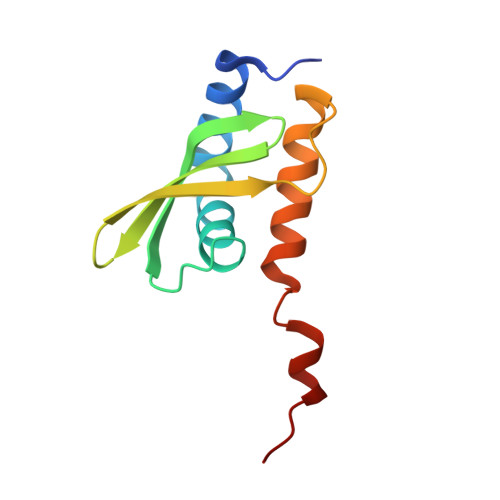A hemoprotein with a zinc-mirror heme site ties heme availability to carbon metabolism in cyanobacteria.
Grosjean, N., Yee, E.F., Kumaran, D., Chopra, K., Abernathy, M., Biswas, S., Byrnes, J., Kreitler, D.F., Cheng, J.F., Ghosh, A., Almo, S.C., Iwai, M., Niyogi, K.K., Pakrasi, H.B., Sarangi, R., van Dam, H., Yang, L., Blaby, I.K., Blaby-Haas, C.E.(2024) Nat Commun 15: 3167-3167
- PubMed: 38609367
- DOI: https://doi.org/10.1038/s41467-024-47486-z
- Primary Citation of Related Structures:
8FM6, 8GBK, 8GDW, 8GF4 - PubMed Abstract:
Heme has a critical role in the chemical framework of the cell as an essential protein cofactor and signaling molecule that controls diverse processes and molecular interactions. Using a phylogenomics-based approach and complementary structural techniques, we identify a family of dimeric hemoproteins comprising a domain of unknown function DUF2470. The heme iron is axially coordinated by two zinc-bound histidine residues, forming a distinct two-fold symmetric zinc-histidine-iron-histidine-zinc site. Together with structure-guided in vitro and in vivo experiments, we further demonstrate the existence of a functional link between heme binding by Dri1 (Domain related to iron 1, formerly ssr1698) and post-translational regulation of succinate dehydrogenase in the cyanobacterium Synechocystis, suggesting an iron-dependent regulatory link between photosynthesis and respiration. Given the ubiquity of proteins containing homologous domains and connections to heme metabolism across eukaryotes and prokaryotes, we propose that DRI (Domain Related to Iron; formerly DUF2470) functions at the molecular level as a heme-dependent regulatory domain.
Organizational Affiliation:
Biology Department, Brookhaven National Laboratory, Upton, NY, USA.















